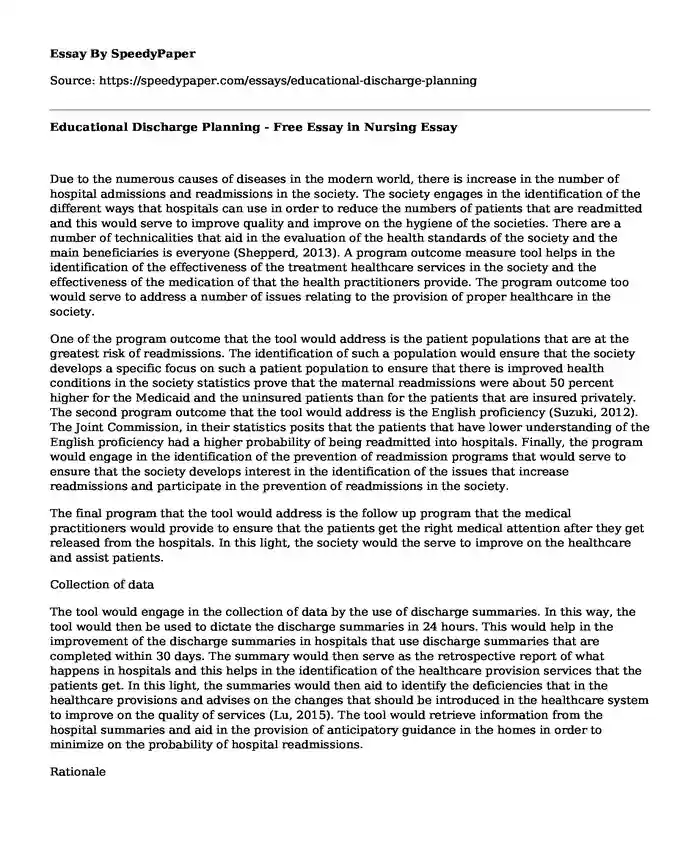
| Type of paper: | Essay |
| Categories: | Education Health and Social Care Nursing |
| Pages: | 3 |
| Wordcount: | 738 words |
Due to the numerous causes of diseases in the modern world, there is increase in the number of hospital admissions and readmissions in the society. The society engages in the identification of the different ways that hospitals can use in order to reduce the numbers of patients that are readmitted and this would serve to improve quality and improve on the hygiene of the societies. There are a number of technicalities that aid in the evaluation of the health standards of the society and the main beneficiaries is everyone (Shepperd, 2013). A program outcome measure tool helps in the identification of the effectiveness of the treatment healthcare services in the society and the effectiveness of the medication of that the health practitioners provide. The program outcome too would serve to address a number of issues relating to the provision of proper healthcare in the society.
One of the program outcome that the tool would address is the patient populations that are at the greatest risk of readmissions. The identification of such a population would ensure that the society develops a specific focus on such a patient population to ensure that there is improved health conditions in the society statistics prove that the maternal readmissions were about 50 percent higher for the Medicaid and the uninsured patients than for the patients that are insured privately. The second program outcome that the tool would address is the English proficiency (Suzuki, 2012). The Joint Commission, in their statistics posits that the patients that have lower understanding of the English proficiency had a higher probability of being readmitted into hospitals. Finally, the program would engage in the identification of the prevention of readmission programs that would serve to ensure that the society develops interest in the identification of the issues that increase readmissions and participate in the prevention of readmissions in the society.
The final program that the tool would address is the follow up program that the medical practitioners would provide to ensure that the patients get the right medical attention after they get released from the hospitals. In this light, the society would the serve to improve on the healthcare and assist patients.
Collection of data
The tool would engage in the collection of data by the use of discharge summaries. In this way, the tool would then be used to dictate the discharge summaries in 24 hours. This would help in the improvement of the discharge summaries in hospitals that use discharge summaries that are completed within 30 days. The summary would then serve as the retrospective report of what happens in hospitals and this helps in the identification of the healthcare provision services that the patients get. In this light, the summaries would then aid to identify the deficiencies that in the healthcare provisions and advises on the changes that should be introduced in the healthcare system to improve on the quality of services (Lu, 2015). The tool would retrieve information from the hospital summaries and aid in the provision of anticipatory guidance in the homes in order to minimize on the probability of hospital readmissions.
Rationale
The tool was adopted due to the various benefits that it has on the society. One of the benefits of the tool is that the tool helps in evaluation of the proficiency of the nurses and then identifies the ways through which the nurses provide their services. This would then help in suggesting the modalities that should be present to aid in the effectiveness of the nurses and help in the offer the relevant training (Suzuki, 2012). Another benefit of the tool is that it would aid in the installation of the telemonitoring technology in the homes of the critically ill patients in order to improve on the service provision in the society. This would help the medical practitioners to identify the patients in critical conditions hence improve the productivity of the medical practitioners
References
Shepperd, S., Lannin, N. A., Clemson, L. M., McCluskey, A., Cameron, I. D., & Barras, S. L. (2013). Discharge planning from hospital to home. Cochrane Database Syst Rev, 1.
Suzuki, S., Nagata, S., Zerwekh, J., Yamaguchi, T., Tomura, H., Takemura, Y., & Murashima, S. (2012). Effects of a multimethod discharge planning educational program for medical staff nurses. Japan Journal of Nursing Science, 9(2), 201-215.
Lu, M., Tang, J., Wu, J., Yang, J., & Yu, J. (2015). Discharge planning for acute coronary syndrome patients in a tertiary hospital: a best practice implementation project. The JBI Database of Systematic Reviews and Implementation Reports, 13(7), 318-334.
Cite this page
Educational Discharge Planning - Free Essay in Nursing. (2019, May 30). Retrieved from https://speedypaper.com/essays/educational-discharge-planning
Request Removal
If you are the original author of this essay and no longer wish to have it published on the SpeedyPaper website, please click below to request its removal:
- Essay Sample: Customer Experience Research
- Free Essay on the Role of a Chief Financial Officer Research
- Essay Example about the Declaration of Independence in the United States
- Interacting with RAD Essay Sample
- Essay Example on Chinese History
- Essay Sample on the Trends, Issues, And Patterns in Intercultural Communication
- Free Essay Example. Prose Fiction 'How Much Land Does a Man Need?'
Popular categories




